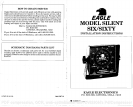
As
you
move
away
from
shore on
a
deep lake,
the
bottom
signal
will
gradually
move around
the
dial until it
reaches zero. If the
dial is calibrated to a
depth
of
60
feet,
the water is 60 feet
deep.
Continue
further,
and the
bottom
signal
will start around
again.
Add
whatever
figure
it shows to
60 to
get
the correct
depth.
The
inside dial on the
Eagle
Model
Silent
Sixty
1 is calibrated from
60
to
120
feet to
help you
read
depths
greater
than 60 feet.
Other
Eagle
models have dual
ranges
that allow
you
to
change
to a
deeper
scale when
you go
deeper
than 60
feet.
SIGNAL INTERPRETATION
Because
your Eagle
is both ex-
tremely
sensitive and
powerful,
it can
give you
an accurate
pic-
ture of the kind of bottom over
which
your
boat is
passing.
A
bottom of firm
sand,
gravel,
shell,
or hard
clay
returns a
bright, fairly
wide
signal.
If
you
are
traveling
over such a bottom
and the
signal
weakens,
it
means
that
you
have moved over
a soft mud bottom. A
soft bottom
absorbs the
sound waves and re-
turns a weak
signal.
In
this
case,
simply
turn
up
the
sensitivity
to
get
a
good
bottom
reading.
A level
bottom with scattered
rocks returns the usual
bottom
signal
—
plus secondary
signals
both above and below it.
This is
caused
by
the different
distances
the sound waves travel.
Those
that
go straight down,
hit a
rock,
and come back
indicate,
cor-
rectly,
that the
top
of the rock
is
above the level of the bottom.
But the sound waves that hit
a
rock toward the outer
edge
of the
cone of sound waves and
are re-
flected back to the transducer
travel further.
Consequently,
their
signals appear
below the
tottom
signal.
A smooth bottom of solid rock
returns a
wide,
bright signal.
Broken rock of various sizes
sends back an even wider
one,
with occasional flashes above
and below
the level of the true
bottom, though
these
signals
aren't so
distinct as the ones re-
turned
by
scattered rocks on a
smooth
botto,m.
Big
rocks or
stumps
on a smooth
bottom send back
signals
above
the level of a smooth
bottom,
the
distance
depending
on their
height.
If
you
watch as
you ap-
proach
a
post
or a
tree, however,
you
will
often see the
signal
climb
up,
then descend the other
side
as
you
continue.
A
steep slope
returns a wide
sig-
nal,
the
steeper
the
wider,
with
the
signal
returned
from
a
high
underwater cliff
being
the
widest. The sure
proof
of a
drop-off
is the sudden
change
of
the
regular depth signal
to a
wide
one,
then back to the usual
width,
but either more shallow
or
deeper
as the boat moves
past.
Brush will return
flashes of
varying heights
above the bot-
tom
signal.
Weeds also tie in
with the
bottom, although they
return weaker
signals
than
brush or tree limbs. In
most
lakes,
weeds don't
grow
in water
more
than 12 or 15 feet
deep
be-
cause of the lack of
sunlight.
Weeds make a
great many thin,
pale signals
on the dial.
The
nicest bottoms
to
survey
with
your
EAGLE
are those that
return a
clear, bright
signal,
with no
spikes
either above
or below
it from scattered rocks.
This is the
easiest bot-
tom
signal
of all
to
read and fish at
any
depth
above it show
up
plainly
on the dial.
Nothing
is more
gratifying
than to find
a
big
school of
largemouth
bass over
clean
gravel
or wall-
eyes
over a smooth
sandbar
—
places
that
these two
popular
fish
like and that
are
easy
to fish
by
the
bottom-
bumping
technique.
It is
easy
to
get
mul-
tiple signals
on the
dial from
bottoms of
this
type.
If
you
are
over water 20
feet
deep,
for
example,
and
turn
up
the
gain you'll
get
signals
at 20 and
40 feet.
9
10
DETECTING A SMOOTH BOTTOM
Gravel or Hard
Clay
Fig.
14
PDF compression, OCR, web-optimization with CVISION's PdfCompressor












